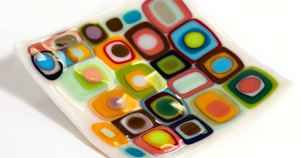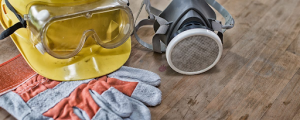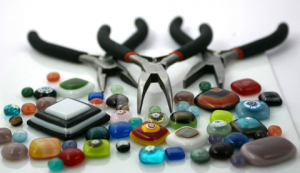
Fusing glass offers a number of possibilities to create both functional & aesthetic pieces of art glasswork. The art of fusing can be used to create jewelry, sculptures, dishware, and more.
Despite the complex appearance, fusing is quite simple. You can learn how to blend many pieces of glass into a stunning art piece with the right tools and practice.
In this article, we’ll guide you through the process of fusing. We’ll explain in detail how to prepare for your fusing projects.
What Is Fusing?
Fusing is the process of blending two or more pieces of compatible glass together. It allows you to manipulate the glass in a variety of ways. It involves heating the pieces of glass that need to be fused in a kiln—olympic kiln, glass kiln, and more at a particular temperature.
After these reach a particular soft point, all pieces fuse together to form a single piece of glass. You can create colorful, dynamic, and unique works of glass art.
Select the Same Coefficient of Expansion (COE)
The key component of a successful fusing is selecting the right glass with the same COE. Different kinds of glass with different COE have a distinct rate at which these expand and contract.
If you fuse multiple pieces of glass with different COE, the final product will crack during cooling. You can use different types of glass—frit, rod, powder, and stringer—with the same COE.
Pro Tip: To check the fusing compatibility of two different glass types, do a test fuse with small pieces first. If these crack during any stage of fusing, avoid using these together.
Thoroughly Clean the Glass Pieces
For a flawless end product, you need to make sure your glass pieces are cleaned well. You can clean with mild soap and water. For better results use a high-quality specialized glass cleaning agent.
- Spray the glass with the cleaning agent.
- Rinse it off with clean water.
- Wipe it with a clean dry cloth.
It helps you get rid of any residue, oil, dirt, or dust and prevents your final glass product from becoming foggy.
Find the Right Kiln
Always choose a kiln that is specifically designed for firing glass. Avoid using kilns that are meant for ceramics. You might not get an accurate result.

Selecting the size of your kiln according to your fusing needs is also important for better results.
- If you’re planning on doing minor glass fusing projects, it’s better to invest in a small kiln.
- If you wish to work on multiple fusing projects, consider buying a large kiln.
Get a Kiln Shelf
Make sure you invest in a high-quality kiln shelf that can withstand temperatures of up to 2000° Fahrenheit (1093° Celsius). It helps you set your glass on the kiln. These are available in a variety of materials such as:
- Cordierite
- High alumina
- Silicon carbide
- Nitride bonded silicon carbide
and more.
Pro Tip: For better fusing, make sure your kiln casting mold also withstands high temperatures similar to the kiln shelf.
Apply Kiln Primer
For smooth fusing, you need to apply kiln primer—kiln wash and kiln paper. Kiln primer has the following benefits:
- It can withstand high temperatures.
- It prevents your glass from sticking to the kiln shelf.
- It ensures your glass comes off easily.
- It also protects your shelf from glaze meltdown.
Difference between Kiln Wash & Kiln Paper
Kiln papers are significantly more expensive than kiln washes. Every time a kiln shelf is used, you need to apply a new kiln wash and remove it after firing. It is a messy and time-consuming process.
On the other hand, you just need to place a new kiln paper every time you fire your kiln.
Purchase the Essential Safety Equipment

Protective Eyeglasses
These will protect your eyes from small sharp glass fragments. These fragments can pop off during cutting, nipping, and breaking the glass.
Heat-Resistant Gloves
These will help you protect your hands from the intense heat when you stick your hands into your kiln.
Respirator/Mask
It protects you from glass dust, also called silica. If you breathe this dust, it can cause damage to your lungs.
First-Aid Kit
When you work with such high temperatures, it is a must to have a first-aid kit ready. It should include:
- Band-aids
- Aspirin/Tylenol
- Neosporin
- Cotton bandages
- Small scissors
- Antiseptic solution
- First-aid tape
et cetera.
Get the Necessary Glass Cutting Tools

Glass Cutters
Glass cutters help you score lines on the sheet glass and cut them into the required shapes.
Mosaic Cutters
Mosaic cutters have sharp cutting tips that allow you to nip glass rods and sheets.
Grozing Pliers
Grozing pliers help you chip away the rough edges of the glass before fusing.
Running Pliers
The slight curves of running pliers help you apply pressure on the glass to break it evenly.
Breaking Pliers
Similar to running pliers, breaking pliers help break the glass along the scored lines.
Marker
A marker allows you to draw designs on the glass before firing. The marks burn off in the firing.
Conclusion
The right way to become a fusing expert is to start with the basics. It is easy to create stunning artwork with glass if you are well prepared.
Now you know how to choose the right types of glass, kiln, kiln shelf, kiln primer, slumping molds, and various other slumping supplies. We hope this guide will help you to better understand what fusing is.
Make sure you have all the cutting tools and safety equipment before you start your fusing project.
